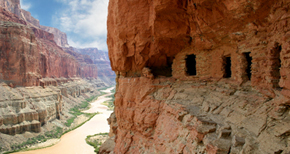What is archaeological or heritage tourism? Heritage sites are places of archaeological or historical significance that have been preserved. Many are open to the public for visitation. They often include museums or interpretive centers with exhibits, trails with informational signs or brochures, and staff who provide interpretative tours. "Heritage Tourism" encompasses the sites themselves, as well as ideas and methods for managing, promoting, and interpreting the sites. There is ongoing discussion in Heritage Tourism about concerns with continued protection of the sites and public access to them.
Visit Archaeology
Planning a trip to visit archaeological sites? These resources can help:
- Archaeology Travel Guides: National Park Service
- Recreate Responsibly: National Park Service
- What We Manage: Bureau of Land Management
- Washington Underground: Archaeology in Downtown Washington, DC: The Center for Heritage Resource Studies at the University of Maryland
- The Ancient Ohio Trail: The University of Cincinnati and the Ohio State University at Newark
- AIA Tour Programs: Archaeological Institute of America
Site Etiquette
Many archaeological sites are unintentionally damaged by visitors who come to enjoy and learn from them. Following these site etiquette guidelines will help reduce damage to fragile sites and will help to save the past for the future. This includes information
on what to do if you find an artifact at a public site. There are also graphical versions of guidelines available
for sharing online.
- All of the things you see at a site are evidence of the lives of people who once lived there, so it is important that you do not move or disturb anything from the site.
- If you find an artifact, you can examine it, draw it, or photograph it, but it is very important that you leave it where you found it. It is useful to record as much information as possible about the location and the description of the artifact.
- Be careful not to step on artifacts or other features at archaeological sites (structures, mounds, ancient trash pits) unless there is the proper infrastructure (for example, boardwalks) in place that will prevent you from damaging these ancient features.
- Don’t lean, sit, stand, or climb on prehistoric walls.
- Staying on established paths or trails will help control erosion and preserve the site.
- Modern trash can contaminate the soil of an archaeological site so be sure not to toss an apple core, banana peel, or cigarette. Food can attract animals, which can be very destructive to sites.
- Place your campsite away from archaeological sites. Campfires produce charcoal that can alter radiocarbon dates of an archaeological site, and food attracts animals that may dig, nest, or burrow on the site.
- Pets can be very destructive to archaeological sites—leave your pooch behind when you are visiting a site.
- Share the information with a professional archaeologist. If you are visiting a state or national park, inform a park ranger, naturalist, or interpreter. Each state has a Historic Preservation Office that records the location of archaeological sites.
These guidelines were adapted from those developed by the U.S. Forest Service.


